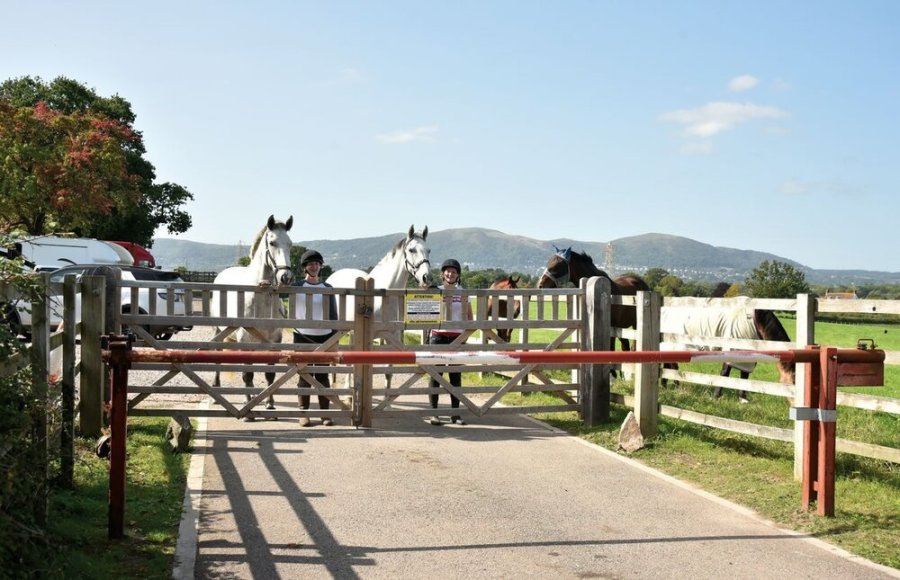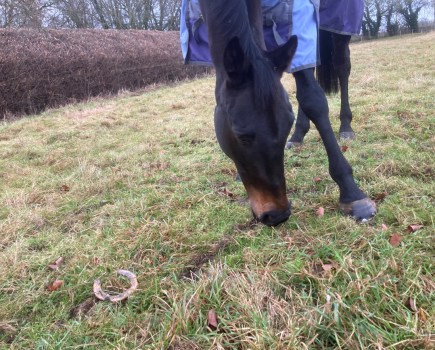Developments in ways to track horses via microchips and passports mean that it’s now harder to steal and sell on horses than it used to be perhaps, but it’s not impossible.
As the nights draw in, it’s a good time to think about the security of your yard, and ensuring your horse stays safe and secure this winter and beyond.
Jo Buckley runs Areion Equestrian, a BHS Approved livery yard in Malvern, Worcestershire.
She has taken great steps to ensure her liveries are as secure as possible.
“When we bought the yard, it was originally a dairy farm and there were no main gates at the bottom of the drive leading onto the road,” explains Jo.
“The first thing we did was to fit an old shipping chain to act as a gate and add security, but it was heavy and difficult to move.
“We then had a double wooden gate fitted, followed by a road barrier for added security.”
Both the double wooden gate and the road barrier are padlocked and there is a security camera facing the gate so that Jo can see who is coming and going.
“We now have three sets of gates from the road to the yard,” says Jo.
“Some professionals find it frustrating having to keep opening and closing gates, but it’s for safety and security.
“It means that if a horse gets loose on the yard, he has three gates to get through before he can get out onto the road.
“I’m very strict about gates being shut at all times, especially the road gates.”
Last one out, lock up
Ensuring the gates and road barrier are locked when the last person leaves is vital.
“We have a multi-user padlock system where all the padlocks can be opened by one set of keys,” adds Jo.
“Each livery has one key. It makes it safer and more efficient. It does, however, mean that if a key is lost the whole system has to be replaced, which costs £350.”
These padlocks are placed on the road barrier, the front gate and the tack locker, a secure metal container with individual tack lockers inside.
“Two liveries share a locker and it can only be opened with their unique key,” explains Jo. “There is also a night lock on the tack container which is a concealed padlock that only four people on the yard have a key to.”
Smile for the camera
Although Jo lives on site, she has installed CCTV in five locations across the yard, including the main driveway, the lorry and trailer parking, the main yards and the barn.
It not only deters thieves but also means that if an accident takes place at the yard, she has evidence of what happened for insurance and horse welfare purposes.
“The cameras play 24/7 and I have access to each of them from my computer at home as well as my mobile, so I can see what’s happening on the yard from the other side of the world at any time of day or night,” Jo says.
“We also have wildlife cameras dotted around as extra security and surveillance. Once a month I climb up and clean the screens on the cameras as spiders love to build webs over them.”
There is also a camera on the property’s only other external gate which is chained and padlocked.
“We have 5ft post and rail fencing with electric which is checked weekly.
Any repairs needed are made instantly to ensure that horses can’t get injured or escape onto the road,” Jo reveals.
“We are also part of the local Neighbourhood Watch and West Midlands Horse Watch, and we find the local equestrian Facebook pages really useful for lost or stolen animals and items.
“We have good relationships with other local yards and keep an eye out for each other, notifying of anything untoward, such as a suspicious car parking up or people hanging around.”
Trailers are wheel-locked and there is a camera on the lorry parking area too.
Keeping connected
“We have a yard Facebook messenger group which we use to let others know if we’re going out hacking, or taking the lorry or trailer, and when we get back,” says Jo.
“There’s also a white board in the tearoom which details dates and times of when professionals such as vets, dentists are coming onto the yard so that everyone knows to expect someone.”
When a new horse arrives, Jo makes note of their medical history in case something happens when the owner isn’t here.
“I also have a copy of their passport so I know their basic information, and I make a list of when all of the horses are due their vaccinations, dentist and farrier appointments.
“Horse welfare is the most important thing, so I do what I can to ensure they stay safe, secure and healthy.”
Microchipping deadline
New legislation to help tackle abuse and improve animal welfare came into effect in June 2018.
It states that all horses, ponies, donkeys and mules in England, Wales and Scotland need to be microchipped, regardless of their age. (Previous legislation only covered animals born since 2009.)
Microchipping means that lost or stolen equines can be reunited with their owners more easily.
Once your horse is microchipped, immediately update your Passport Issuing Organisation (PIO) with the microchip number and they will upload the data to the Central Equine Database (CED).
By accessing the CED you can:
- Check your horse’s passport details
- Quickly report your horse missing
- Check if a horse is legally for sale
The CED will also allow local authorities and police to track down the owners of dumped equines.
It’s important to check that your equine has a microchip AND that this microchip is recorded on the CED.
You can check your horse’s microchip at equineregister.co.uk.
The microchipping deadline varies according to where you live:
England — 1 October 2020
Wales — 12 February 2021
Scotland — 28 March 2021
Microchips must be implanted by a qualified veterinary surgeon. Failure to comply by the deadline is an offence and could result a fine. Don’t be caught out— act now!
Is your tack safe?
Security of the tackroom is vital to ensure all equipment stays safe, and everyone using the tackroom needs to share the responsibility.
“It should be a dry, secure, lockable room with good lighting — security cameras and additional alarm systems are desirable,” advises Oonagh.
“Make sure only essential users have access and consider combination locks with changeable codes. It’s also important to ensure that the tackroom location and contents aren’t inadvertently highlighted on social media.”
The BHS recommends permanently marking and photographing any other valuable equipment such as showjumps, and easily movable items like electric fencing units, so that if items are stolen you can supply all the details to the police.
“Quad bikes and trailers are prone to theft too, so use locks, tag trackers, clamps and hitch locks,” adds Oonagh.
“With regards to your horse, take a clear set of photographs of him too, in both summer and winter. This will aid identification should he go missing.”
Preventing fires
“Fires can have devastating effects and it’s vital that yard owners take all the preventative measures they can to minimise the fire risk,” says Oonagh Meyer, head of approvals at the British Horse Society.
“Situations will differ in every yard and some may be at greater risk than others due to their location or accessibility. If the yard is remote, for example, then the response by the emergency services may well take longer.”
It is a legal requirement for all businesses, including riding schools, to have a preventative plan and emergency plans in place to identify the procedure to follow in case of fire or other emergencies.
“It is important to ensure that all staff, as well as clients, are fully informed about the yard’s fire procedures,” advises Oonagh.
“Emergency plans must include priority communications, and measures to safely extricate people and horses. Practising a fire drill and evacuation procedure on a regular basis is best practice.”
The preventative measures to take should include, but are not limited to:
- Displaying clear NO SMOKING signage
- Undertaking regular de-cobwebbing
- Storing flammables appropriately in terms of location and accessibility
- Having regular electric safety checks by a qualified electrician
- Ensuring that all electrical equipment that comes onto the yard is compliant with PAT testing requirements
- Consideration of the location of the muck heap and hay/straw storage in relation to other buildings
Additionally, the BHS advises centres to contact their local fire brigade for location-specific advice and instructions, such as how to find the yard and the exact location of the water supply for speedy access. Consider using the what3words app.
Lots more useful information on fire safety can be found at bhs.org.uk/stable-fire-safety
Read the full article and much more in the December issue of Your Horse Magazine









